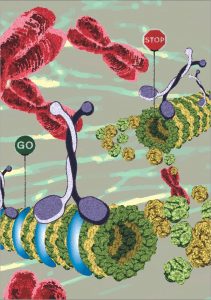Microtubule-associated protein, HMMR, acts as a regulator in controlling chromosome segregation during cell division
NUS researchers led by Dr. Jiang Zemin (a former PhD student) from Prof Liou Yih-Cherng’s group in the Department of Biological Sciences, NUS, discovered recently that a microtubule-associated protein, HMMR, acts as a regulator in controlling chromosome segregation during cell division, an event that is critical for genome stability.
Mitosis is a common but important process in eukaryotic cells, during which the genetic information is duplicated and equally separated to daughter cells consequently, to ensure the proliferation and keep the genome integrity at the same time. This process is under the regulation of microtubules, which are classified as kinetochore-microtubules (kMTs), interpolar microtubules (iMTs) and astral microtubules. Decades of studies have dissected the functions and mechanisms of kMTs in regulating chromosome congression and segregation, but the roles of iMTs and its regulatory mechanism are little understood.
A paper, entitled “Hyluronan-mediated motility receptor governs chromosome segregation by regulating microtubules sliding within the bridging fiber”, recently published in Advanced Biology journal, led by Dr. Jiang Zemin. This research article reported that the microtubule-associated protein HMMR is critical for proper chromosome segregation through regulating the iMTs-formed fibers. When HMMR gene is depleted, the duplicated chromosomes cannot be equally separated; as a result, the separation is delayed, which causes the genome instability in daughter cells. Subsequently, it may induce tumorigenesis.
This study identified a novel mechanism of how iMTs formed bridging fibers is modulated by microtubule-associated proteins during cell division and may provide evidence linking genome instability with human diseases such as cancer.
Figure (art design) Legend:
“Concerning the function of HMMR, the “Go” (in the presence of HMMR) and “Stop” (in the absence of HMMR) represent two situations of the microtubule tracks (the bridging fiber) for proper microtubule sliding, respectively, whose stability is determined by the association of HSET (indicated by the white and black motor protein) on the mitotic spindle.”

